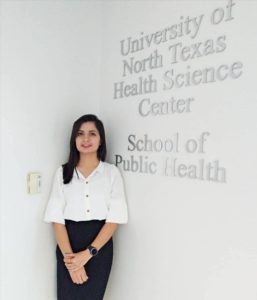COVID contact tracing uncovers the stories behind the numbers
August 10, 2020 • Uncategorized
 Behind the numbers of COVID-19 are real people. Real stories. Real experiences.
Behind the numbers of COVID-19 are real people. Real stories. Real experiences.
In her final term as an HSC School of Public Health student, Sujita Adhikari joined Tarrant County Public Health’s (TCPH) contact tracing team, calling quarantined, COVID-positive patients to track their connections to other community members who may also have been exposed to the virus.
This major community health effort was quickly set up in March as the pandemic spread across U.S. cities and states.
Adhikari was one of the HSC students involved in the COVID response collaboration between the University and the public health department.
“Our HSC students were ready to step up and respond to the call when needed,” said Dr. Dennis Thombs, SPH Dean. “They were able to put their public health training to work in a very real way, serving the community at a time of crisis. For many of these students who joined the effort, the work still continues.”
Adhikari said that even with a full schedule finishing up for graduation – toward her MPH in Maternal and Child Health, leading to a Program Manager position with HSC’s INCEDO office of continuing education – it was “really important to get involved” in the community’s COVID contract tracing efforts.
During April and May, she called approximately 60 COVID-positive patients, both asking and answering questions, listening to their experiences, sometimes working with a translator to gather needed details.
She rejoiced with those who were recovering and feeling very thankful.
She offered support and resources to those who felt concerned and afraid.
And she was there for patients who were lonely, sad, not doing so well – and for those who were missing their families, those who had no families, individuals out of work, and the people who were unsure if they would have a home to go to when they left the hospital.
“Some days were emotionally exhausting,” Adhikari said. “Our supervisors encouraged us to take breaks in between calls to clear our minds and just breathe, maybe go outside for a few minutes to process it all and put our work into perspective.”
“I talked to people who trusted me so much. I couldn’t stop thinking about those conversations at the end of the day.”
Others didn’t want to talk or disclose their personal health information. Some couldn’t recall their experiences, how they might have contracted the virus, or others they may have come in contact with.
“It was very challenging to create a connection within a few short minutes. You have to develop a rapport right away. Some people were open to that, while others were more guarded, or even angry about the overall circumstances of the pandemic,” Adhikari said.
Contact tracers also risked calling people who were resting and didn’t want to be disturbed, or those who were having a really bad day.
Contact tracing isn’t an easy process. It takes time, and investigators like Adhikari are only the first step that leads to other team efforts like reporting and monitoring, infection control and those who follow up with close contacts of infected patients.
Investigators like Adhikari asked questions about where people worked, if they had traveled recently, large gatherings they might have attended, people they may have come in contact with, their signs and symptoms, risk factors and underlying conditions, and if they suspected where they might have been exposed to COVID.
They gave advice on protocols, whether retesting would be required, when quarantine could end and when patients could feel safe being around others. If someone needed a thermometer, it was arranged.
“People had so many questions and weren’t sure where to reach out,” Adhikari said. “We were all learning and navigating the situation as we lived through it.”
Working as a contact tracer has its own personal challenges too. The nature of the job calls for employees to be at the public health department. Social distancing was well enforced, with computers stationed six feet apart and masks required. Temperatures were taken daily, and student shifts were designed to accommodate classes, job interviews for positions after graduation, and other obligations.
For Adhikari, the opportunity to serve the community at such an important time was “a privilege.”
She moved to the U.S. from Nepal after completing her pharmacy degree and working in the field. She was led to HSC because of her interest in maternal and child health and her desire to work closely with the community and impact public health on a broad scale.
“Being able to help North Texas during the COVID-19 pandemic was an important experience for me. I feel as though I was really able to help others and be a part of finding solutions,” she said.
“It felt really good to feel trusted by so many patients who are relying on us during this very challenging time.”

Social media